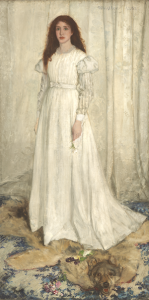Art for Art’s Sake
Until the early 1860s, Whistler painted realistic portrayals of London life. And was very successful at it. But at the beginning of that decade, he determined to make a painting that would be admired for its own sake, rather than for its subject. He had, while living in Paris, become familiar with the philosophy of French critic Théophile Gautier, who argued a painter should make art for it’s own sake (“l’art pour l’art”) and not for any other purpose.
If the man who paints only the tree, or flower, or other surface he sees before him were an artist, the king of artists would be the photographer. It is for the artist to do something beyond this.
– James McNeill Whistler, The Red Rag

“Symphony in White No.1: The White Girl,” 1862, Oil on canvas, Harris Whittemore Collection. Courtesy of the National Gallery of Art, Washington
In 1861, Whistler made a picture, The White Girl, with this new approach in mind. Joanna Hiffernan, his red-haired mistress, was the model. The artist painted her as a figure “standing against a window which filters the light through a transparent white muslin curtain — but the figure receives a strong light from the right and therefore the picture barring the red hair is one gorgeous mass of brilliant white.” The White Girl was presented for exhibition to London’s prestigious Royal Academy, but it was rejected. The next year, it was declined by the Salon of 1863 in Paris, as were paintings by Gustave Courbet, Édouard Manet, and Camille Pissaro. All tolled, the Salon turned away 4,000 paintings, many of them “new” art. The furor was so intense that Emperor Napoleon III created another exhibition, called the “Salon des Réfusés” in which all the rejected pictures were exhibited. There, The White Girl attracted nearly as much attention as Édouard Manet’s Le Déjeuner sur l’herbe. “We find the whites excellent,” exclaimed his friend Henri Fantin-Latour. “Courbet calls your picture an apparition… Baudelaire finds it charming, exquisite, absolutely delicate. Legros, Manet, Bracquemond, De Balleroy, and myself, we all think it admirable.” The White Girl suggests Whistler’s increasing interest in the process of “art making”, which would come to mean new choices in color, composition and subject. This preoccupation would lead him away from Realism and closer to the philosophy of the Aesthetic Movement, whose followers were friends of Whistler’s. Stressing formal, painterly qualities of a picture over story, the followers of the Aesthetic Movement emphasized the creation of beauty as, said his friend artist Dante Gabriel Rossetti, “the only absolute aim” of art. With The White Girl, Whistler began a nearly decade-long process of self-education and discovery, as he moved towards the creation of his signature contribution to art history, the Nocturne form.


